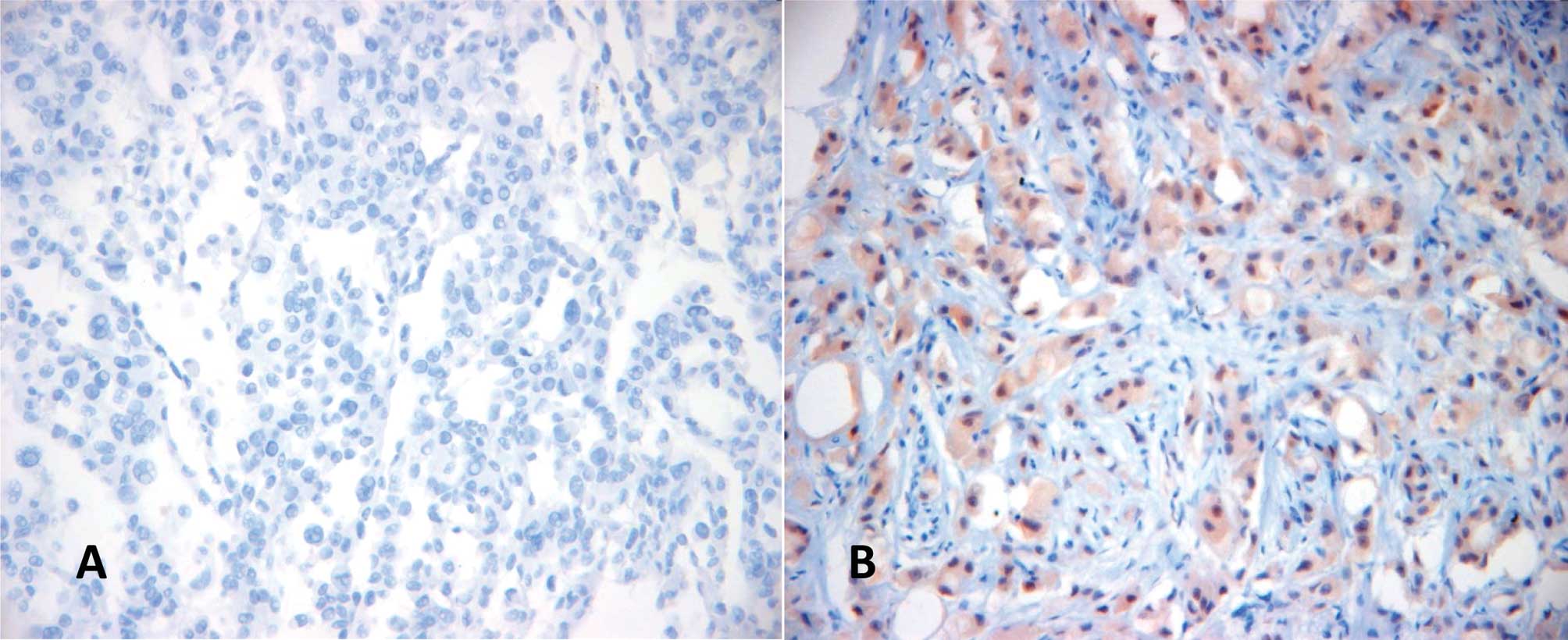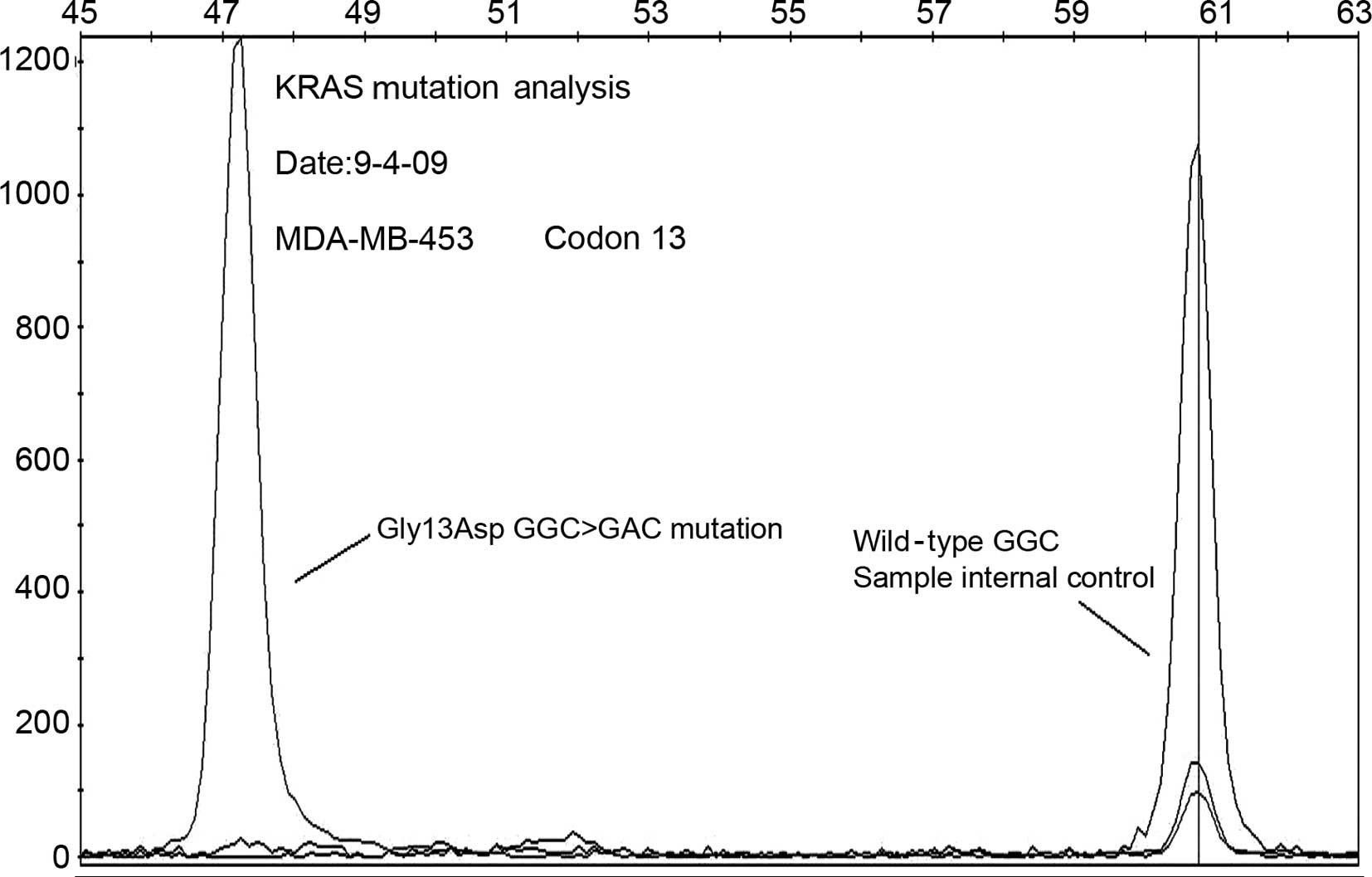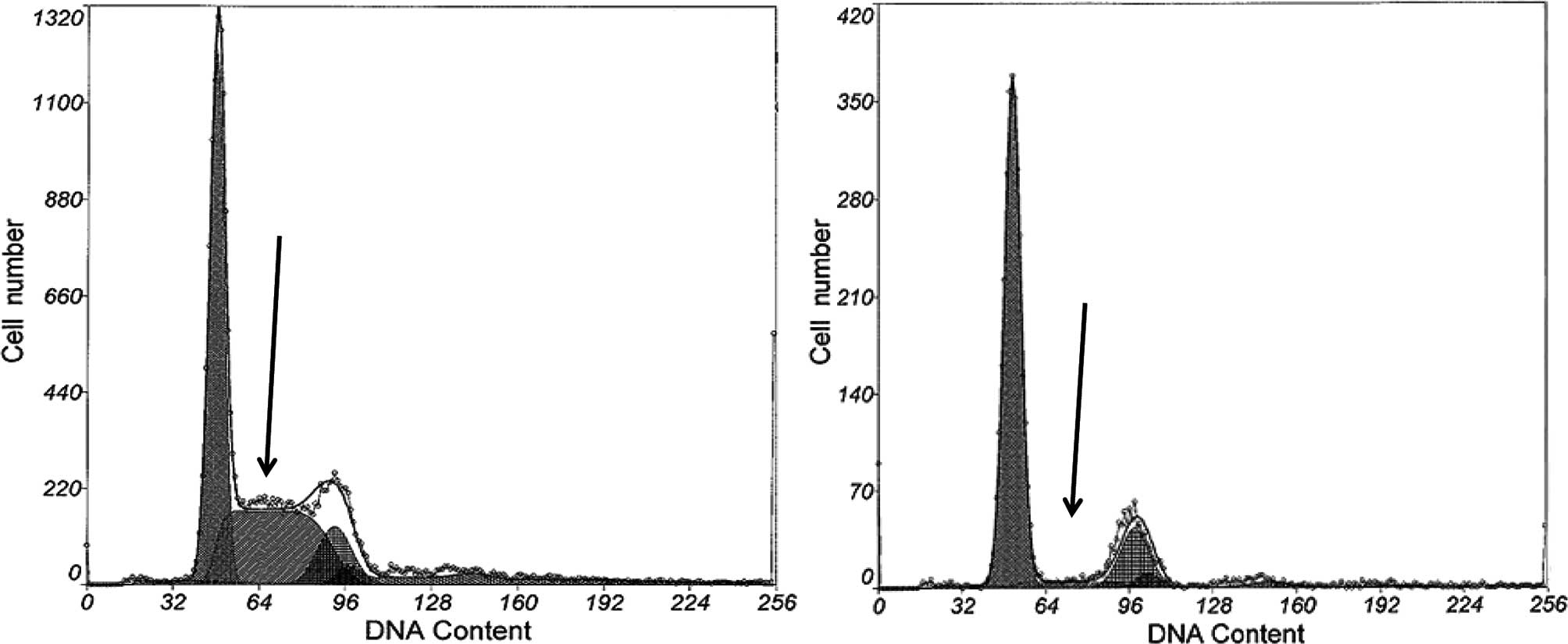|
1
|
Tavassoli FA and Devilee P: World Health
Organization Classification of tumours Pathology and genetics of
tumours of the breast and female genital organs. IARC Press; Lyon:
2003
|
|
2
|
Perou CM, Sørlie T, Eisen MB, et al:
Molecular portraits of human breast tumours. Nature. 406:747–752.
2000. View
Article : Google Scholar : PubMed/NCBI
|
|
3
|
Sørlie T, Perou CM, Tibshirani R, et al:
Gene expression patterns of breast carcinomas distinguish tumor
subclasses with clinical implications. Proc Natl Acad Sci USA.
98:10869–10874. 2001.PubMed/NCBI
|
|
4
|
Weigelt B, Horlings HM, Kreike B, et al:
Refinement of breast cancer classification by molecular
characterization of histological special types. J Pathol.
216:141–150. 2008. View Article : Google Scholar : PubMed/NCBI
|
|
5
|
Gatalica Z: Immunohistochemical analysis
of apocrine breast lesions. Consistent over-expression of androgen
receptor accompanied by the loss of estrogen and progesterone
receptors in apocrine metaplasia and apocrine carcinoma in situ.
Pathol Res Pract. 193:753–758. 1997.
|
|
6
|
Tavassoli FA, Purcell CA, Bratthauer GL,
et al: Androgen receptor expression along with loss of bcl-2, ER,
and PR expression in benign and malignant apocrine lesions of the
breast: implications for therapy. Breast J. 2:261–269. 1996.
View Article : Google Scholar
|
|
7
|
Bratthauer GL, Lininger RA, Man YH and
Tavassoli FA: Androgen and estrogen receptor mRNA status in
apocrine carcinomas. Diagn Mol Pathol. 11:113–118. 2002. View Article : Google Scholar : PubMed/NCBI
|
|
8
|
Farmer P, Bonnefoi H, Becette V, et al:
Identification of molecular apocrine breast tumours by microarray
analysis. Oncogene. 24:4660–4671. 2005. View Article : Google Scholar : PubMed/NCBI
|
|
9
|
Burdall SE, Hanby AM, Lansdown MRJ and
Speirs V: Breast cancer cell lines: friend or foe? Breast Cancer
Res. 5:89–95. 2003. View
Article : Google Scholar : PubMed/NCBI
|
|
10
|
Lacroix M and Leclercq G: Relevance of
breast cancer cell lines as models for breast tumours: an update.
Breast Cancer Res Treat. 83:249–289. 2004. View Article : Google Scholar : PubMed/NCBI
|
|
11
|
Kao J, Salari K, Bocanegra M, et al:
Molecular profiling of breast cancer cell lines defines relevant
tumor models and provides a resource for cancer gene discovery.
PLoS One. 4:e61462009.PubMed/NCBI
|
|
12
|
Neve RM, Chin K, Fridlyand J, et al: A
collection of breast cancer cell lines for the study of
functionally distinct cancer subtypes. Cancer Cell. 10:515–27.
2006. View Article : Google Scholar : PubMed/NCBI
|
|
13
|
Naderi A and Hughes-Davies L: A
functionally significant cross-talk between androgen receptor and
erbB2 pathways in estrogen receptor negative breast cancer.
Neoplasia. 10:542–548. 2008.
|
|
14
|
Chia KM, Liu J, Francis GD and Naderi A: A
feedback loop between androgen receptor and ERK signaling in
estrogen receptor-negative breast cancer. Neoplasma. 13:154–66.
2011.PubMed/NCBI
|
|
15
|
De Longueville F, Lacroix M, Barbuto AM,
et al: Molecular characterization of breast cancer cell lines by a
low-density microarray. Int J Oncol. 27:881–892. 2005.PubMed/NCBI
|
|
16
|
Doane AS, Danso M, Lal P, et al: An
estrogen receptor-negative breast cancer subset characterized by a
hormonally regulated transcriptional program and response to
androgen. Oncogene. 25:3994–4008. 2006. View Article : Google Scholar
|
|
17
|
Hall RE, Birrell SN, Tilley WD and
Sutherland RL: MDA-MB-453, an androgen-responsive human breast
carcinoma cell line with high level androgen receptor expression.
Eur J Cancer. 30A:484–490. 1994. View Article : Google Scholar : PubMed/NCBI
|
|
18
|
Vranic S, Tawfik O, Palazzo J, et al: EGFR
and HER-2/neu expression in invasive apocrine carcinoma of the
breast. Mod Pathol. 23:644–653. 2010. View Article : Google Scholar : PubMed/NCBI
|
|
19
|
Bhargava R, Beriwal S, Striebel JM and
Dabbs DJ: Breast cancer molecular class ERBB2: preponderance of
tumors with apocrine differentiation and expression of basal
phenotype markers CK5, CK5/6, and EGFR. Appl Immunohistochem Mol
Morphol. 18:113–118. 2010. View Article : Google Scholar : PubMed/NCBI
|
|
20
|
Varga Z, Zhao J, Ohlschlegel C, Odermatt B
and Heitz PU: Preferential HER-2/neu overexpression and/or
amplification in aggressive histological subtypes of invasive
breast cancer. Histopathology. 44:332–338. 2004. View Article : Google Scholar : PubMed/NCBI
|
|
21
|
Zhang XT, Kang LG, Ding L, Vranic S,
Gatalica Z and Wang ZY: A positive feedback loop of ER-α36/EGFR
promotes malignant growth of ER-negative breast cancer cells.
Oncogene. 30:770–780. 2011.
|
|
22
|
Wang Z, Zhang X, Shen P, Loggie BW, Chang
Y and Deuel TF: A variant of estrogen receptor-{alpha},
hER-{alpha}36: transduction of estrogen- and antiestrogen-dependent
membrane-initiated mitogenic signaling. Proc Natl Acad Sci USA.
103:9063–9068. 2006.
|
|
23
|
Subhawong AP, Subhawong T, Nassar H, et
al: Most basal-like breast carcinomas demonstrate the same Rb−/p16+
immunophenotype as the HPV-related poorly differentiated squamous
cell carcinomas which they resemble morphologically. Am J Surg
Pathol. 33:163–75. 2009.PubMed/NCBI
|
|
24
|
Milde-Langosch K, Bamberger AM, Rieck G,
Kelp B and Löning T: Overexpression of the p16 cell cycle inhibitor
in breast cancer is associated with a more malignant phenotype.
Breast Cancer Res Treat. 67:61–70. 2001. View Article : Google Scholar : PubMed/NCBI
|
|
25
|
Elayat G, Selim AG and Wells CA:
Alterations of the cell cycle regulators cyclin D1, cyclin A, p27,
p21, p16, and pRb in apocrine metaplasia of the breast. Breast J.
15:475–482. 2009. View Article : Google Scholar : PubMed/NCBI
|
|
26
|
Wolff AC, Hammond ME, Schwartz JN, et al:
American Society of Clinical Oncology/College of American
Pathologists guideline recommendations for human epidermal growth
factor receptor 2 testing in breast cancer. J Clin Oncol.
25:118–145. 2007. View Article : Google Scholar
|
|
27
|
Shaffer LG and Tommerup N: ISCN 2005 An
International System for Human Cytogenetic Nomenclature. Karger;
Basel: 2005
|
|
28
|
Vranic S, Teruya B, Repertinger S, Ulmer
P, Hagenkord J and Gatalica Z: Assessment of HER2 gene status in
breast carcinomas with polysomy of chromosome 17. Cancer.
117:48–53. 2011. View Article : Google Scholar : PubMed/NCBI
|
|
29
|
Shackelford W, Deng S, Murayama K and Wang
J: A new technology for mutation detection. Ann N Y Acad Sci.
1022:257–262. 2004. View Article : Google Scholar : PubMed/NCBI
|
|
30
|
Hollestelle A, Nagel JH, Smid M, et al:
Distinct gene mutation profiles among luminal-type and basal-type
breast cancer cell lines. Breast Cancer Res Treat. 121:53–64. 2010.
View Article : Google Scholar : PubMed/NCBI
|
|
31
|
Arriola E, Marchio C, Tan DS, et al:
Genomic analysis of the HER2/TOP2A amplicon in breast cancer and
breast cancer cell lines. Lab Invest. 88:491–503. 2008. View Article : Google Scholar : PubMed/NCBI
|
|
32
|
Mackay A, Tamber N, Fenwick K, et al: A
high-resolution integrated analysis of genetic and expression
profiles of breast cancer cell lines. Breast Cancer Res Treat.
118:481–498. 2009. View Article : Google Scholar : PubMed/NCBI
|
|
33
|
Taniyama K, Ishida K, Toda T, et al:
Tyrosine1248-phosphorylated HER2 expression and HER2 gene
amplification in female invasive ductal carcinomas. Breast Cancer.
15:231–240. 2008. View Article : Google Scholar : PubMed/NCBI
|
|
34
|
Belsches-Jablonski AP, Biscardi JS, Peavy
DR, Tice DA, Romney DA and Parsons SJ: Src family kinases and HER2
interactions in human breast cancer cell growth and survival.
Oncogene. 20:1465–1475. 2001. View Article : Google Scholar : PubMed/NCBI
|
|
35
|
Hollestelle A, Elstrodt F, Nagel JHA,
Kallemeijn WW and Schutte M: Phosphatidylinositol-3-OH kinase or
RAS pathway mutations in human breast cancer cell lines. Mol Cancer
Ther. 5:195–201. 2007.PubMed/NCBI
|
|
36
|
Von Lintig FC, Dreilinger AD, Varki NM,
Wallace AM, Casteel DE and Boss GR: Ras activation in human breast
cancer. Breast Cancer Res Treat. 62:51–62. 2000.PubMed/NCBI
|
|
37
|
Torii S, Yamamoto T, Tsuchiya Y and
Nishida E: ERK MAP kinase in G1 cell cycle progression and cancer.
Cancer Sci. 97:697–702. 2006. View Article : Google Scholar : PubMed/NCBI
|
|
38
|
Lu Z and Xu S: ERK1/2 MAP kinases in cell
survival and apoptosis. IUBMB Life. 58:621–631. 2006. View Article : Google Scholar : PubMed/NCBI
|
|
39
|
Roberts PJ and Der CJ: Targeting the
Raf-MEK-ERK mitogen-activated protein kinase cascade for the
treatment of cancer. Oncogene. 26:3291–3310. 2007. View Article : Google Scholar : PubMed/NCBI
|
|
40
|
McCubrey JA, Steelman LS, Chappell WH, et
al: Role of the RAF/MEK/ERK pathway in cell growth, malignant
transformation and drug resistance. Biochim Biophysic Acta.
1773:1263–1284. 2007. View Article : Google Scholar : PubMed/NCBI
|
|
41
|
Davies H, Bignell GR, Cox C, et al:
Mutations of the BRAF gene in human cancer. Nature. 417:949–954.
2002. View Article : Google Scholar : PubMed/NCBI
|
|
42
|
Capela G, Cronauer-Mitra S, Peinado MA and
Perucho M: Frequency and spectrum of mutations at codons 12 and 13
of the C-K-Ras gene in human tumors. Environ Health Perspect.
93:125–131. 1991. View Article : Google Scholar : PubMed/NCBI
|
|
43
|
Myakis S, Sourvinos G and Spandidos DA:
Differential expression and mutation of the ras family genes in
human breast cancer. Biochem Biophys Res Commun. 251:609–612. 1998.
View Article : Google Scholar : PubMed/NCBI
|
|
44
|
Sánchez-Muñoz A, Gallego E, de Luque V, et
al: Lack of evidence for KRAS oncogenic mutations in
triple-negative breast cancer. BMC Cancer. 10:1362010.PubMed/NCBI
|
|
45
|
Karnoub AE and Weinberg RA: Ras oncogenes:
split personalities. Nat Rev Mol Cell Biol. 9:517–531. 2008.
View Article : Google Scholar : PubMed/NCBI
|
|
46
|
Geradts J and Wilson PA: High frequency of
aberrant p16(INK4A) expression in human breast cancer. Am J Pathol.
149:15–20. 1996.PubMed/NCBI
|
|
47
|
Emig R, Magener A, Ehemann V, et al:
Aberrant cytoplasmic expression of the p16 protein in breast cancer
is associated with accelerated tumour proliferation. Br J Cancer.
78:1661–1668. 1998. View Article : Google Scholar : PubMed/NCBI
|
|
48
|
Di Vinci A, Perdelli L, Banelli B, et al:
p16INK4a promoter methylation and protein expression in breast
fibroadenoma and carcinoma. Int J Cancer. 114:414–421.
2005.PubMed/NCBI
|













